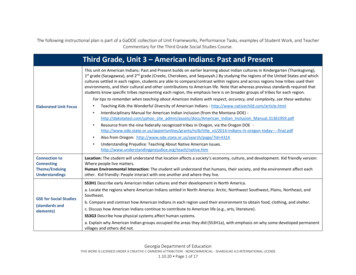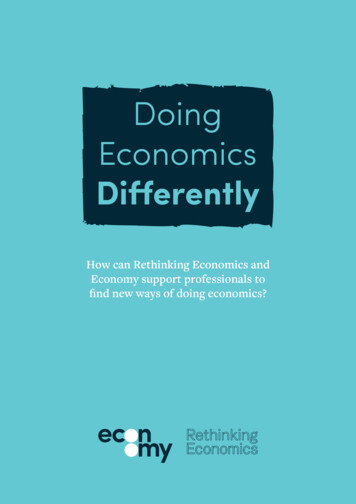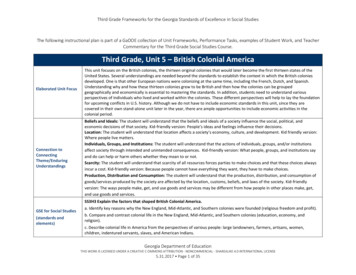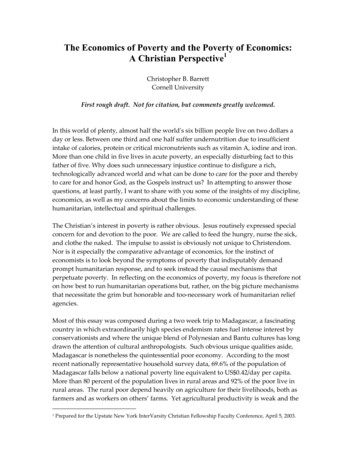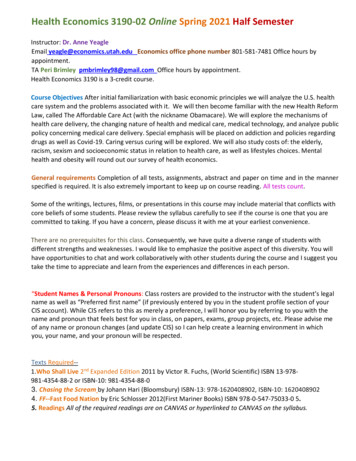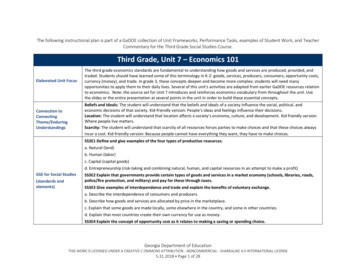
Transcription
The following instructional plan is part of a GaDOE collection of Unit Frameworks, Performance Tasks, examples of Student Work, and TeacherCommentary for the Third Grade Social Studies Course.Third Grade, Unit 7 – Economics 101Elaborated Unit FocusThe third grade economics standards are fundamental to understanding how goods and services are produced, provided, andtraded. Students should have learned some of this terminology in K-2: goods, services, producers, consumers, opportunity costs,currency (money), and trade. In grade 3, these concepts deepen and become more complex; students will need manyopportunities to apply them to their daily lives. Several of this unit’s activities are adapted from earlier GaDOE resources relationto economics. Note: the source set for Unit 7 introduces and reinforces economics vocabulary from throughout the unit. Usethe slides or the entire presentation at several points in the unit in order to build these essential concepts.Beliefs and Ideals: The student will understand that the beliefs and ideals of a society influence the social, political, andeconomic decisions of that society. Kid-friendly version: People’s ideas and feelings influence their decisions.Location: The student will understand that location affects a society’s economy, culture, and development. Kid friendly version:Where people live matters.Scarcity: The student will understand that scarcity of all resources forces parties to make choices and that these choices alwaysincur a cost. Kid-friendly version: Because people cannot have everything they want, they have to make choices.Connection toConnectingTheme/EnduringUnderstandingsSS3E1 Define and give examples of the four types of productive resources.a. Natural (land)b. Human (labor)c. Capital (capital goods)d. Entrepreneurship (risk-taking and combining natural, human, and capital resources in an attempt to make a profit)GSE for Social Studies(standards andelements)SS3E2 Explain that governments provide certain types of goods and services in a market economy (schools, libraries, roads,police/fire protection, and military) and pay for these through taxes.SS3E3 Give examples of interdependence and trade and explain the benefits of voluntary exchange.a. Describe the interdependence of consumers and producers.b. Describe how goods and services are allocated by price in the marketplace.c. Explain that some goods are made locally, some elsewhere in the country, and some in other countries.d. Explain that most countries create their own currency for use as money.SS3E4 Explain the concept of opportunity cost as it relates to making a saving or spending choice.Georgia Department of EducationTHIS WORK IS LICENSED UNDER A CREATIVE C OMMONS ATTRIBUTION - NONCOMMERCIAL - SHAREALIKE 4.0 INTERNATIONAL LICENSE5.31.2018 Page 1 of 28
ELAGSE3RI4: Determine the meaning of general academic and domain-specific words and phrases in a text relevant to a grade 3topic or subject area.ELAGSE3RI7: Use information gained from illustrations (e.g., maps, photographs) and the words in a text to demonstrateunderstanding of the text (e.g., where, when, why, and how key events occur).ELAGSE3RI9: Compare and contrast the most important points and key details presented in two texts on the same topic.ELAGSE3SL1: Engage effectively in a range of collaborative discussions (one-on-one, in groups, and teacher-led) with diversepartners on grade 3 topics and texts, building on others’ ideas and expressing their own clearly.c. Ask questions to check understanding of information presented, stay on topic, and link their comments to the remarks ofothers.d. Explain their own ideas and understanding in light of the discussion.ELAGSE3W3: Write narratives to develop real or imagined experiences or events using effective technique, descriptive details,and clear event sequences.a. Establish a situation and introduce a narrator and/or characters; organize an event sequence that unfolds naturally.Connection to K-5 GSEfor ELA/Science/Mathb. Use dialogue and descriptions of actions, thoughts, and feelings to develop experiences and events or show the response ofcharacters to situations. c. Use temporal words and phrases to signal event order.d. Provide a sense of closure.ELAGSE3W1: Write opinion pieces on topics or texts, supporting a point of view with reasons.a. Introduce the topic or book they are writing about, state an opinion, and create an organizational structure that lists reasons.b. Provide reasons that support the opinion.c. Use linking words and phrases (e.g., because, therefore, since, for example) to connect opinion and reasons.d. Provide a concluding statement or section.ELAGSE3W5: With guidance and support from peers and adults, develop and strengthen writing as needed by planning, revising,and editing.ELAGSE3RI9: Compare and contrast the most important points and key details.ELAGSE3W7: Conduct short research projects that build knowledge about a topic.ELAGSE3W8: Recall information from experience or gather information from print and digital sources; take brief notes onsources and sort evidence into provided categories.Connection to SocialStudies Matrices(informationprocessing and/or mapand globe skills)Map and Globe skills –6 (use map key/legend to acquire information from historical, physical, political, resource, product, andeconomic maps), 8 (draw conclusions and make generalizations based on information from map)Information Processing Skills – 1 (compare similarities and differences), 3 (identify issues and/or problems and alternativesolutions), 4 (fact/opinion), 5 (main idea, detail, sequence, cause/effect), 6 (identify and use primary and secondary sources), 9(construct charts and tables), 10 (analyze artifacts), 11 (draw conclusions and make generalizations)Georgia Department of EducationTHIS WORK IS LICENSED UNDER A CREATIVE C OMMONS ATTRIBUTION - NONCOMMERCIAL - SHAREALIKE 4.0 INTERNATIONAL LICENSE5.31.2018 Page 2 of 28
Essential Questions and Related Supporting/Guiding QuestionsEnduringUnderstanding 1:1.How do people’s ideas and feelings affect economic decisions?2.How does where we live shape how we live economically?3.How do entrepreneurs contribute to the economy?4.How is scarcity related to productive resources?5.What does paying our taxes mean for our lives?6.How are trade and interdependence related to scarcity?7.What does opportunity cost look like in our daily lives?Beliefs and IdealsEnduringUnderstanding 2:LocationEnduringUnderstanding 3:ScarcityGeorgia Department of EducationTHIS WORK IS LICENSED UNDER A CREATIVE C OMMONS ATTRIBUTION - NONCOMMERCIAL - SHAREALIKE 4.0 INTERNATIONAL LICENSE5.31.2018 Page 3 of 28
Sample Instructional Activities/AssessmentsActivity One – Three Main Productive ResourcesEQ: How is scarcity related to productive resources?Hook: Show the class a completed project like a loaf of bread or a bag of cookies. Ask them what it took to make this product and jot down responses.(students may say things like flour, butter, yeast some might add an oven, plastic to wrap it in, a way to close the bag, some may bring up the baker andthe owner of the business where it was sold, etc. ) Lead them to conclude that many things went into making this product. We call all of those thingsproductive resources. Let’s explore these further.1 – There are three kinds of resources used in creating products and providing services: Natural, human, and capitol resources. Post these three labels onchart paper or the white board and work with students to define and list examples of them. Natural resources are things like water, coal, trees, land, and crops that come from earth. These natural resources produce raw materials that areused in production. In the case of the bread example, wheat or other grains are ground into flour, butter comes from cows, etc. Show the class aresource map of Georgia or of the United States and ask what natural resources are noted on the map. What kinds of things could be producedfrom the natural resources found on the map? Human resources (or labor) are both the physical and mental work that goes into making something. In the making of bread, the baker andmerchant are both human parts of production. Capital resources are man-made physical resources (like buildings, tools, machines, and equipment) used in production so things like the mixer,the tools, the oven, the building, etc. would all be capital resources.2 - Have students turn their journal sideways and make a 3 column chart, with the same headings as the chart above. Ask students to include a briefdefinition and examples of each type of resource.Note: Some students may think of money when they use the word capital. Money is NOT a capital resource in economics terms, it is a medium ofexchange. We will talk about money more in a later activity.3 – As a way to reinforce the three types of resources, tell students to listen as you read aloud a book like The Ox-Cart Man by Donald Hall or The TortillaFactory by Gary Paulson. Have pairs of students work together and tell what natural, human, and capital resources were present in the story.Note: This lesson can be expanded to explore the way that other items are made. Oz Charles wrote a book called How Is a Crayon Made? and there aremany youtube videos that explain how this and other manufactured objects are made. These provide opportunities for students to view or read anddetermine the different kinds of resources used in producing the particular objects. Always preview books and videos before using with your students, toinsure that they meet your needs and work for your students and community.Georgia Department of EducationTHIS WORK IS LICENSED UNDER A CREATIVE C OMMONS ATTRIBUTION - NONCOMMERCIAL - SHAREALIKE 4.0 INTERNATIONAL LICENSE5.31.2018 Page 4 of 28
SS3E1 Define and give examples of the four types of productive resources.GSE Standards andElementsa. Natural (land)b. Human (labor)c. Capital (capital goods)d. Entrepreneurship (risk-taking and combining natural, human, and capital resources in an attempt to make a profit)Literacy StandardsELAGSE3RI4: Determine the meaning of general academic and domain-specific words and phrases in a text relevant to a grade 3topic or subject area.ELAGSE3RI7: Use information gained from illustrations (e.g., maps, photographs) and the words in a text to demonstrateunderstanding of the text (e.g., where, when, why, and how key events occur).ELAGSE3RI9: Compare and contrast the most important points and key details presented in two texts on the same topic.ELAGSE3SL1: Engage effectively in a range of collaborative discussions (one-on-one, in groups, and teacher-led) with diversepartners on grade 3 topics and texts, building on others’ ideas and expressing their own clearly.c. Ask questions to check understanding of information presented, stay on topic, and link their comments to the remarks ofothers.d. Explain their own ideas and understanding in light of the discussion.ELAGSE3RI9: Compare and contrast the most important points and key details.Social Studies MatricesEnduringUnderstanding(s)Map and Globe skills –6 (use map key/legend to acquire information from historical, physical, political, resource, product, andeconomic maps), 8 (draw conclusions and make generalizations based on information from map)Information Processing Skills – 1 (compare similarities and differences), 3 (identify issues and/or problems and alternativesolutions), 4 (fact/opinion), 5 (main idea, detail, sequence, cause/effect), 6 (identify and use primary and secondary sources), 9(construct charts and tables), 10 (analyze artifacts), 11 (draw conclusions and make generalizations)Beliefs and Ideals: The student will understand that the beliefs and ideals of a society influence the social, political, andeconomic decisions of that society. Kid-friendly version: People’s ideas and feelings influence their decisions.Location: The student will understand that location affects a society’s economy, culture, and development. Kid friendly version:Where people live matters.Scarcity: The student will understand that scarcity of all resources forces parties to make choices and that these choices alwaysincur a cost. Kid-friendly version: Because people cannot have everything they want, they have to make choices.Georgia Department of EducationTHIS WORK IS LICENSED UNDER A CREATIVE C OMMONS ATTRIBUTION - NONCOMMERCIAL - SHAREALIKE 4.0 INTERNATIONAL LICENSE5.31.2018 Page 5 of 28
Activity Two – EntrepreneursEQ: How do entrepreneurs contribute to the economy?Hook: Ask students if they know any of the following people and why they are famous – Colonel Sanders, Steve Jobs, Bill Gates, etc. Students may respondthat they helped to start businesses. These entrepreneurs organize productive resources in order to start a business. Ask students to discuss what kinds ofqualities make an entrepreneur.1 – In our standard, entrepreneurship plus the three types of resources make up four productive resources.2 – Read and discuss the picture book, Uncle Jed’s Barbershop by Margaret King Mitchell and discuss what traits Uncle Jed possesses that might make himan entrepreneur.3 – Review all four productive resources and then divide the class into small groups. Ask each group to pick one productive resource and develop a skit toillustrate it. Keep your chosen resource private since the class will try to guess what you’re portraying. When skits are ready, present to the class and havethem guess which resource is being portrayed.GSE Standardsand ElementsSS3E1 Define and give examples of the four types of productive resources.a. Natural (land)b. Human (labor)c. Capital (capital goods)d. Entrepreneurship (risk-taking and combining natural, human, and capital resources in an attempt to make a profit)LiteracyStandardsSocial StudiesMatricesELAGSE3RI4: Determine the meaning of general academic and domain-specific words and phrases in a text relevant to a grade 3 topicor subject area.ELAGSE3RI7: Use information gained from illustrations (e.g., maps, photographs) and the words in a text to demonstrateunderstanding of the text (e.g., where, when, why, and how key events occur).ELAGSE3RI9: Compare and contrast the most important points and key details presented in two texts on the same topic.ELAGSE3SL1: Engage effectively in a range of collaborative discussions (one-on-one, in groups, and teacher-led) with diverse partnerson grade 3 topics and texts, building on others’ ideas and expressing their own clearly.c. Ask questions to check understanding of information presented, stay on topic, and link their comments to the remarks of others.d. Explain their own ideas and understanding in light of the discussion.ELAGSE3RI9: Compare and contrast the most important points and key details.ELAGSE3W7: Conduct short research projects that build knowledge about a topic.ELAGSE3W8: Recall information from experience or gather information from print and digital sources; take brief notes on sources andsort evidence into provided categories.Information Processing Skills – 1 (compare similarities and differences), 8 (identify social studies reference resources to use for aspecific purpose)Georgia Department of EducationTHIS WORK IS LICENSED UNDER A CREATIVE C OMMONS ATTRIBUTION - NONCOMMERCIAL - SHAREALIKE 4.0 INTERNATIONAL LICENSE5.31.2018 Page 6 of 28
EnduringUnderstandingsBeliefs and Ideals: The student will understand that the beliefs and ideals of a society influence the social, political, and economicdecisions of that society. Kid-friendly version: People’s ideas and feelings influence their decisions.Location: The student will understand that location affects a society’s economy, culture, and development. Kid friendly version: Wherepeople live matters.Scarcity: The student will understand that scarcity of all resources forces parties to make choices and that these choices always incur acost. Kid-friendly version: Because people cannot have everything they want, they have to make choices.Georgia Department of EducationTHIS WORK IS LICENSED UNDER A CREATIVE C OMMONS ATTRIBUTION - NONCOMMERCIAL - SHAREALIKE 4.0 INTERNATIONAL LICENSE5.31.2018 Page 7 of 28
Activity Three – Government Goods and ServicesEQ: What does paying our taxes mean for our lives?Hook: Begin by asking students what are taxes. What are some ways that taxes affect their lives?1 – Unpack the standard SS3E2 by defining each of the following concepts: government, goods, services, market economy, taxes. Divide the class intogroups, then assign each word to a group and have them create a Frayer chart for the word. See a Frayer chart organizer following this activity. Aftercompleting the graph, groups “teach” the word to the class. As each word is defined and explored, students should note the words and meanings in theirsocial studies journals.2 – Use the Think Aloud strategy with one of the following picture books to explain how taxes work: Paying Taxes (A True Book) by Sarah De Capua, WhyDo We Pay Taxes? (Civics Q & A series) by Leslie Harper, Taxes by Linda Crotta Brennan, or Taxes, Taxes! Where The Money Goes by Nancy Loewen. Moredirections on the think aloud process may be found at http://www.readingrockets.org/strategies/think alouds .ORUse the think aloud process to show and discuss the video “Economy In and Between Communities,” found at GPB/Discovery Learning (All Georgiateachers are provided free access to this large collection of videos. See ucation for directions.) Thevideo is 17:07 minutes long and should be shown to students in the smaller segments available online, pausing every few moments to discuss and relatethe video to the EQs above. The entire script may be downloaded ahead of time for teacher use. After each segment, have students take notes (visual ortext or a combination of the two) in their interactive notebooks/social studies journals.3 – Have each student or group create a large poster illustrating goods and services that are provided by tax monies. Explain the poster to class membersand add items to posters as needed.4 - Write an opinion paragraph explaining what public goods and services you consider most important to your life. Provide evidence to support your claim.Follow the ELA standards on opinion writing. Use the paragraphs to gauge students’ understanding of the standard and correct misconceptions as needed.GSE Standards andElementsSS3E2 Explain that governments provide certain types of goods and services in a market economy (schools, libraries, roads,police/fire protection, and military) and pay for these through taxes.Literacy StandardsELAGSE3SL1: Engage effectively in a range of collaborative discussions (one-on-one, in groups, and teacher-led) with diversepartners on grade 3 topics and texts, building on others’ ideas and expressing their own clearly.Social Studies Matricesc. Ask questions to check understanding of information presented, stay on topic, and link their comments to the remarks ofothers.d. Explain their own ideas and understanding in light of the discussion.EnduringUnderstanding(s)ELAGSE3W1: Write opinion pieces on topics or texts, supporting a point of view with reasons.a. Introduce the topic or book they are writing about, state an opinion, and create an organizational structure that lists reasons.b. Provide reasons that support the opinion.c. Use linking words and phrases (e.g., because, therefore, since, for example) to connect opinion and reasons.d. Provide a concluding statement or section.Georgia Department of EducationTHIS WORK IS LICENSED UNDER A CREATIVE C OMMONS ATTRIBUTION - NONCOMMERCIAL - SHAREALIKE 4.0 INTERNATIONAL LICENSE5.31.2018 Page 8 of 28
ELAGSE3W5: With guidance and support from peers and adults, develop and strengthen writing as needed by planning, revising,and editing.ELAGSE3RI9: Compare and contrast the most important points and key details.ELAGSE3W7: Conduct short research projects that build knowledge about a topic.ELAGSE3W8: Recall information from experience or gather information from print and digital sources; take brief notes onsources and sort evidence into provided categories.Map and Globe skills –6 (use map key/legend to acquire information from historical, physical, political, resource, product, andeconomic maps), 8 (draw conclusions and make generalizations based on information from map)Information Processing Skills – 1 (compare similarities and differences), 3 (identify issues and/or problems and alternativesolutions), 4 (fact/opinion), 5 (main idea, detail, sequence, cause/effect), 6 (identify and use primary and secondary sources), 9(construct charts and tables), 10 (analyze artifacts), 11 (draw conclusions and make generalizations)Beliefs and Ideals: The student will understand that the beliefs and ideals of a society influence the social, political, andeconomic decisions of that society. Kid-friendly version: People’s ideas and feelings influence their decisions.Location: The student will understand that location affects a society’s economy, culture, and development. Kid friendly version:Where people live matters.Scarcity: The student will understand that scarcity of all resources forces parties to make choices and that these choices alwaysincur a cost. Kid-friendly version: Because people cannot have everything they want, they have to make choices.Georgia Department of EducationTHIS WORK IS LICENSED UNDER A CREATIVE C OMMONS ATTRIBUTION - NONCOMMERCIAL - SHAREALIKE 4.0 INTERNATIONAL LICENSE5.31.2018 Page 9 of 28
Frayer ModelDefinition in your own wordsFacts/characteristics or visual imageWordExamplesNon-examplesGeorgia Department of EducationTHIS WORK IS LICENSED UNDER A CREATIVE C OMMONS ATTRIBUTION - NONCOMMERCIAL - SHAREALIKE 4.0 INTERNATIONAL LICENSE5.31.2018 Page 10 of 28
Activity Four – Interdependence and TradeEQ: How are trade and interdependence related to scarcity? How does where we live shape how we live economically?Hook: Bring in an assortment of grocery items in their packaging or with labels and put one on each student table. Ask students to do some detective workand try to determine where the product was grown and/or packaged. Students may need to do some research to find answers. Share out with the class.We will connect this hook activity to a discussion about trade and interdependence.1 – What is trade? Students should already have knowledge about this term from the history units we have explored this year. This is a good chance toconnect back to understandings about the American Indians, European Explorers, and the British Colonies, all of which had trade as a central concept.2 – Introduce the term interdependence – ask students to work in pairs to break down this word and predict what it might mean. Discuss all of their ideasand then share this definition: interdependence means being mutually reliant on others. Have them brainstorm examples of when they have beeninterdependent in their lives. How is their family or the class interdependent?3 – Vocabulary review – create a flip book with the following terms and definitions: Interdependence; Goods, services, and prices; trade; voluntaryexchange; local, national and global production; currency. Students should add visual/textual examples to illustrate each concept on the third flap of theflip book.4 – How are trade and interdependent related? From the hook and the discussion, students should be able to see that we are interdependent with otherstates and nations in many ways, including many economic ways. Read and discuss the book How to Make An Apple Pie and See the World by MarjoriePriceman. In what ways does this story tell us more about trade and interdependence? In what ways is scarcity part of the story of our trade andinterdependent economy? Use a world map to track where products came from in this story. (A blank world map is provided if you wish to have studentsdo their own labeling and tracking of things we trade around the world.)5 – Assign students to create their own story, or narrative, which illustrates the way that trade and interdependence are part of our daily lives. Follow theELA standards for narrative writing.GSE Standards andElementsSS3E3 Give examples of interdependence and trade and explain the benefits of voluntary exchange.a. Describe the interdependence of consumers and producers.b. Describe how goods and services are allocated by price in the marketplace.c. Explain that some goods are made locally, some elsewhere in the country, and some in other countries.d. Explain that most countries create their own currency for use as money.Literacy StandardsELAGSE3RI4: Determine the meaning of general academic and domain-specific words and phrases in a text relevant to a grade 3topic or subject area.ELAGSE3RI7: Use information gained from illustrations (e.g., maps, photographs) and the words in a text to demonstrateunderstanding of the text (e.g., where, when, why, and how key events occur).ELAGSE3RI9: Compare and contrast the most important points and key details presented in two texts on the same topic.ELAGSE3SL1: Engage effectively in a range of collaborative discussions (one-on-one, in groups, and teacher-led) with diversepartners on grade 3 topics and texts, building on others’ ideas and expressing their own clearly.Georgia Department of EducationTHIS WORK IS LICENSED UNDER A CREATIVE C OMMONS ATTRIBUTION - NONCOMMERCIAL - SHAREALIKE 4.0 INTERNATIONAL LICENSE5.31.2018 Page 11 of 28
c. Ask questions to check understanding of information presented, stay on topic, and link their comments to the remarks ofothers.d. Explain their own ideas and understanding in light of the discussion.ELAGSE3RI9: Compare and contrast the most important points and key details.ELAGSE3W3: Write narratives to develop real or imagined experiences or events using effective technique, descriptive details,and clear event sequences.Social Studies Matricesa. Establish a situation and introduce a narrator and/or characters; organize an event sequence that unfolds naturally.b. Use dialogue and descriptions of actions, thoughts, and feelings to develop experiences and events or show the response ofcharacters to situations. c. Use temporal words and phrases to signal event order.d. Provide a sense of closure.ELAGSE3W7: Conduct short research projects that build knowledge about a topic.EnduringUnderstanding(s)ELAGSE3W8: Recall information from experience or gather information from print and digital sources; take brief notes onsources and sort evidence into provided categories.Map and Globe skills –8 (draw conclusions and make generalizations based on information from map)Information Processing Skills – 1 (compare similarities and differences), 8 (identify social studies reference resources to use fora specific purpose), 9 (construct charts and tables)Beliefs and Ideals: The student will understand that the beliefs and ideals of a society influence the social, political, andeconomic decisions of that society. Kid-friendly version: People’s ideas and feelings influence their decisions.Location: The student will understand that location affects a society’s economy, culture, and development. Kid friendly version:Where people live matters.Scarcity: The student will understand that scarcity of all resources forces parties to make choices and that these choices alwaysincur a cost. Kid-friendly version: Because people cannot have everything they want, they have to make choices.Georgia Department of EducationTHIS WORK IS LICENSED UNDER A CREATIVE C OMMONS ATTRIBUTION - NONCOMMERCIAL - SHAREALIKE 4.0 INTERNATIONAL LICENSE5.31.2018 Page 12 of 28
Georgia Department of EducationTHIS WORK IS LICENSED UNDER A CREATIVE C OMMONS ATTRIBUTION - NONCOMMERCIAL - SHAREALIKE 4.0 INTERNATIONAL LICENSE5.31.2018 Page 13 of 28
Georgia Department of EducationTHIS WORK IS LICENSED UNDER A CREATIVE C OMMONS ATTRIBUTION - NONCOMMERCIAL - SHAREALIKE 4.0 INTERNATIONAL LICENSE5.31.2018 Page 14 of 28
World MapGeorgia Department of EducationTHIS WORK IS LICENSED UNDER A CREATIVE C OMMONS ATTRIBUTION - NONCOMMERCIAL - SHAREALIKE 4.0 INTERNATIONAL LICENSE5.31.2018 Page 15 of 28
Activity Five – Trade & MoneyEQ: How are trade and interdependence related to scarcity? How does money help us with trade?Hook: Conduct a barter activity. Ask students to bring items from home to trade with one another. Encourage students to trade for the item they wantmost and to make as many trades as they can in a five-minute period. Discuss the trading. How many were able to get the items they wanted? What wouldmake this trading easier? (if students don’t mention money making trades easier, ask them if they think exchanging money for items could result in morepeople being able to get what they want.)1 – Ask students to draw a picture showing people trading.2 – Discuss ways that people use their money (income): spending on goods and services, taxes, saving, gifts, etc. Have students create their own lists ofhow people use money in their social studies journals.3 – Talk about what is used for money and what makes it work: money should be scarce, durable, portable, and divisible. What do we use here in theU.S.? What are other things that have been used for money in the past (precious metals, tobacco, shells, paper, beads, etc.) How did these old forms ofmoney meet the four criteria for money? Ask students to explain why they think we use the money that we do now?Resources for teaching about money include children’s encyclopedias available for your class or district, or the following children’s informational texts:Making Cents: The Nuts and Bolts of Money and A Whole Lot More, The Story of Money by Betsy Maestro, and How Much? Visiting Markets Around theWorld by Ted Lewin.4 – What are the uses of money? It helps with trade, measures the value of items, makes it easier to save, etc. Give examples of each.5 – Compare and contrast our mo
Commentary for the Third Grade Social Studies Course. Third Grade, Unit 7 – Economics 101 Elaborated Unit Focus The third grade economics standards are fundamental to understanding h

